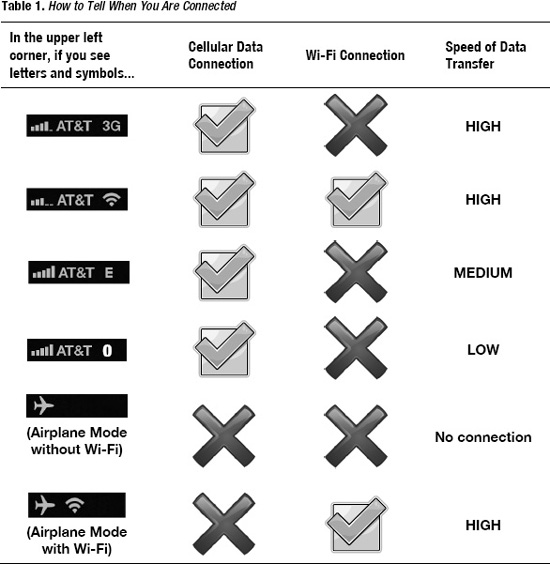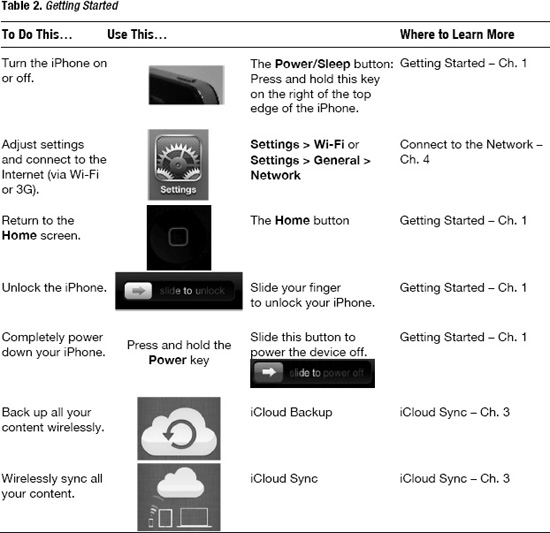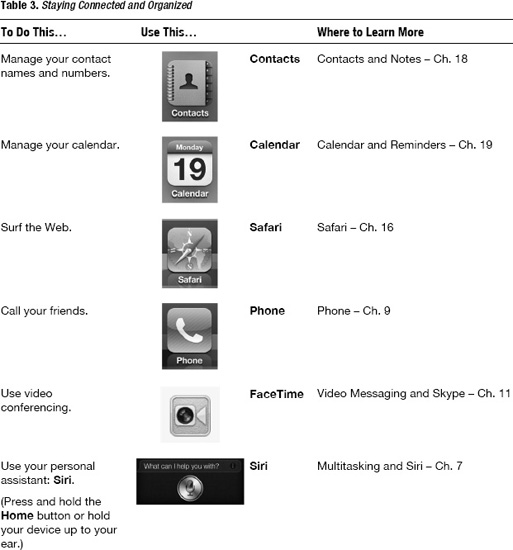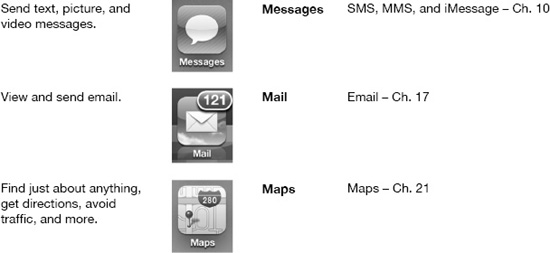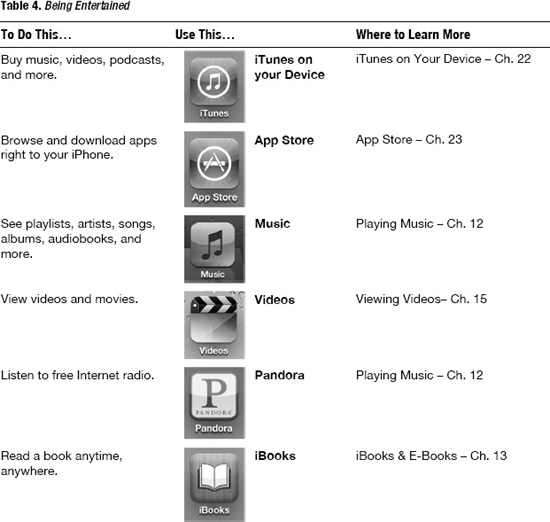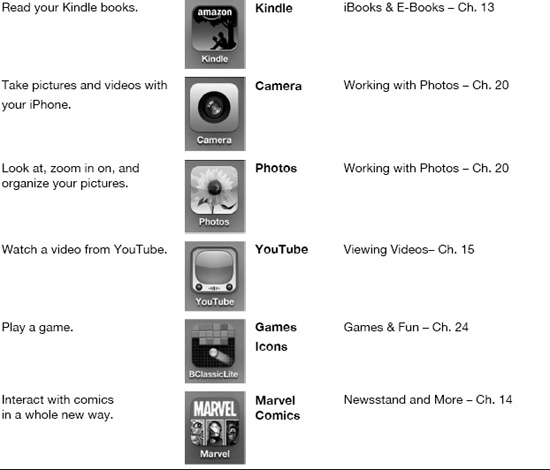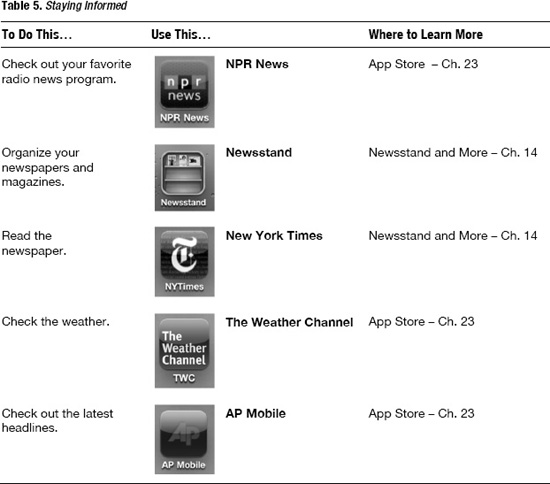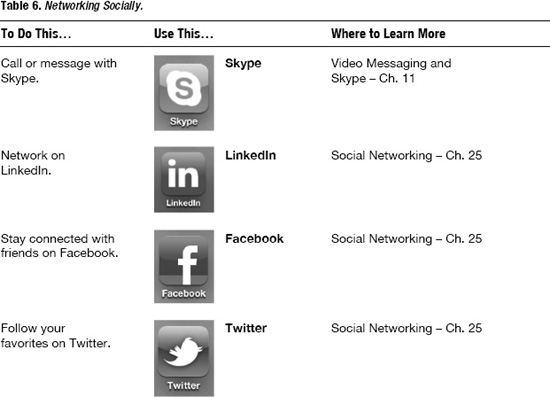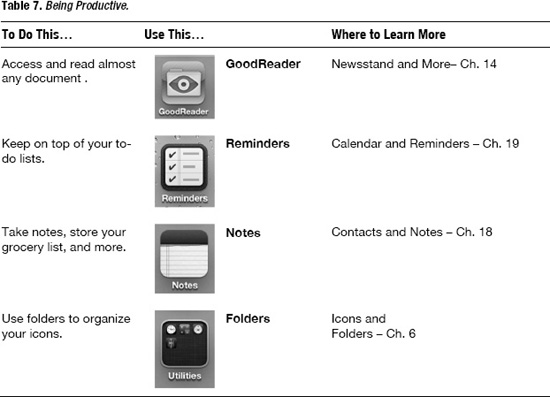Part I
Quick Start Guide
In your hands is one of the most exciting devices to hit the market in quite some time: the iPhone 4S. This Quick Start Guide will help get you and your new iPhone 4S up and running in a hurry. You'll learn all about the buttons, switches, and ports, and how to use the responsive touch screen, multitask and be introduced to Siri, the amazing voice-activated personal assitant. Our App Reference Tables introduce you to the apps on your iPhone—and serves as a quick way to find out how to accomplish a task.
Getting Around Quickly
This Quick Start Guide is meant to be just that—a tool that can help you jump right in and find information in this book, as well as learn the basics of how to get around and enjoy your iPhone right away.
We'll start with the nuts and bolts in our “Learning Your Way Around” section, which covers what all the keys, buttons, switches, and symbols mean and do on your iPhone. In this section, you'll see some handy features such as multitasking by double-clicking the Home button. We will also introduce you to Siri, the amazing new personal assistant function on your iPhone. You'll also learn how to interact with the menus, submenus, and set switches—tasks that are required in almost every application on your iPhone. You'll also find out how to read your connectivity status and what to do when you travel on an airplane.
TIP: Check out Chapter 2: “Typing, Copy, and Search” for great typing tips and more.
In the “Touch Screen Basics” section, we will help you learn how to touch, swipe, flick, zoom, and more.
Later, in the “App Reference Tables,” section, we've organized the app icons into general categories, so you can quickly browse through the icons and jump to a section in the book to learn more about the app a particular icon represents. This guide also includes several handy tables designed to help you get up and running with your iPhone quickly:
- Getting Started (Table 2)s
- Stay Organized (Table 3)
- Be Entertained (Table 4)
- Stay Informed (Table 5)
- Network Socially (Table 6)
- Be Productive (Table 7)
Let's get started!
Learning Your Way Around
To help you get comfortable with your iPhone, we will start with the basics—what the buttons, keys, and switches do—and then move onto how you start apps and navigate the menus. Probably the most important status indicator on your iPhone, besides the battery, is the one that shows network status in the upper-left corner. Understanding what these status icons do is crucial to getting the most out of your iPhone.
Keys, Buttons, and Switches
Figure 1 shows all the things you can do with the buttons, keys, switches, and ports on your iPhone. Go ahead and try out a few things to see what happens. Swipe left to search, swipe right to see more icons, try double-clicking the Home button to bring up the multitasking App Switcher bar, and then press and hold the Power/Sleep key to power your phone on or off. Have some fun getting acquainted with your device.

Figure 1. The iPhone's buttons, ports, switches, and keys
Switching Apps (AKA Multitasking)
One of the great new features introduced with the iPhone 4 is the ability to multitask or jump between applications (see Figure 2).
Double-click the Home button to bring up the App Switcher bar in the bottom of the screen. Next, swipe right to see more icons and tap any icon of any app you want to start. If you don't see the icon you want, then single-click the Home button to see the entire Home screen. Repeat these steps to jump back to the app you just left. The nice thing is that the app you just jumped from is always shown as the first app on the App Switcher bar.
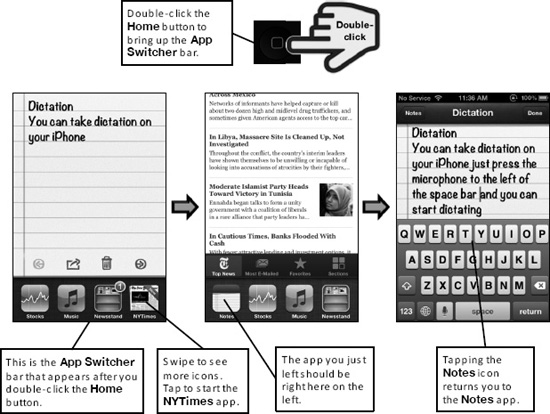
Figure 2. Multitask (switch apps) by double-clicking the Home button.
Using Siri (Your Personal Assistant)
There are two ways to launch Siri, your personal digital assistant. First, you can press and hold the Home button. Alternatively, if your iPhone is on and you've enabled the feature in Settings (see Chapter 7: “Multitasking and Siri”), simply bring the device to your ear.
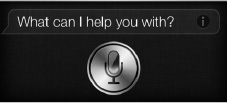
Your Home screen will slide up to reveal a silver Microphone icon. Wait for Siri to beep before you begin to speak, and then speak in a clear voice, at a moderate speed, just as you'd speak to another person. When you're done speaking, wait for Siri to beep again. Then the fun begins.
Apple recommends you talk to Siri the way you'd talk to another person. Don't try to remember a set list of commands or queries—there are far too many types and variations. Instead, just ask for what you want. Here are some examples of what Siri can do for you:
- Set up reminders, calendar appointments, and clock alarms and timers.
- Send texts, iMessages, and emails.
- Play music.
- Search for location-based information like restaurant and business listings, and then search for directions to those (and other) locations.
- Respond to silly questions such as asking your iPhone to marry you!
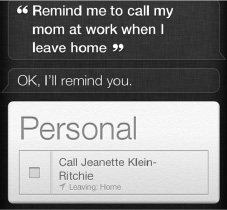
The fun really begins when you combine these functions together into interactions. Siri can read a message requesting a dinner date, search for a restaurant, get directions, send back a confirmation message, and add an appointment for the dinner—all as part of an interactive confirmation. Check out Chapter 7: “Multitasking and Siri” for more details.
Using Voice Dictation
New to the iPhone Keyboard is a small Microphone button immediately to the left of the Space Bar.

Tap it and your screen will slide up to reveal a glowing, purple microphone. Speak to it as you would to Siri; and when you're finished, tap the Done button. Everything you said will be transcribed and entered as text.
While no text-to-speech engine is perfect, Siri does a pretty good job of transcribing what you said. If it makes any mistakes, just edit it as you would text you typed with the keyboard. Learn more in Chapter 7: “Multitasking and Siri.”
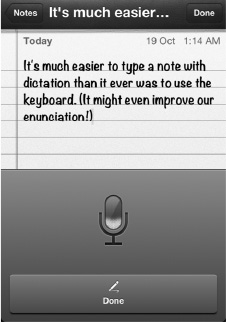
Music Controls and Portrait Screen Rotation Lock
You will see a few more icons if you swipe from left to right in the App Switcher bar. You can lock the screen rotation by tapping the leftmost icon, and the middle buttons control the currently playing music or video. The last icon on the right will start your Music app (see Figure 3).

Figure 3. The Screen Rotation Lock button, Music app controls, and Music icon in the App Switcher bar
Starting Apps and Using Soft Keys
Some apps have soft keys at the bottom of the screen, such as the Music app shown in Figure 4.
To see and use the soft keys in the Music app, you must have some content (e.g., music, videos, and podcasts) on your iPhone. See Chapter 3: “Sync with iCloud. iTunes and More” for help with syncing your music, videos, and more to your iPhone. Follow these steps to launch the Music app and become familiar with using the soft keys to get around:
- Tap the Music icon to start the Music app.
- Touch the Songs soft key at the bottom to view your albums.
- Touch the Playlists soft key to view a list of your artists.
- Try all the soft keys in Music.
- In some apps, such as the Music app, you will see the More soft key in the lower-right corner. Tap this key to see additional soft keys or even rearrange your soft keys.
TIP: You know which soft key is selected because it is highlighted—usually with a color. The other soft keys are gray, but can still be touched.
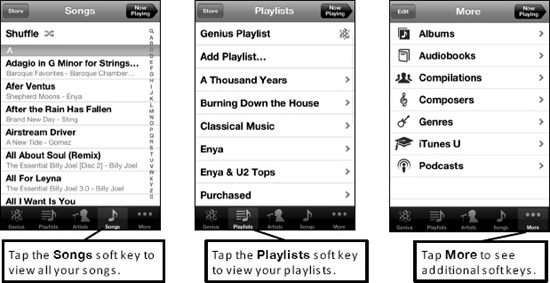
Figure 4. Working with soft keys in apps
Menus, Submenus, and Switches
Once you are in an app, you can select any menu item by simply touching it. Using the Settings app as an example, tap Sounds, and then tap Ringtone, as shown in Figure 5.
Submenus are any menus below the main menu.
TIP: You know there is a submenu or another screen if you see the Greater Than symbol next to the menu item (>).
How do you get back to the previous screen or menu? Tap the button in the top of the menu. If you're in the Ringtone screen, for example, you simply touch the Sounds button.
You'll see a number of switches on the iPhone, such as the one next to Airplane Mode shown in Figure 5. To set a switch (e.g., change the switch from OFF to ON), just touch it.
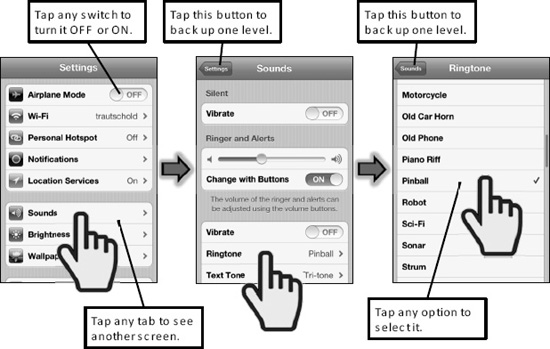
Figure 5. Selecting menu items, navigating submenus, and setting switches
Reading the Connectivity Status Icons
Most of the functions on your iPhone work only when you are connected to the Internet (e.g., email, your browser, the App Store, and the iTunes app), so you need to know when you're connected. Understanding how to read the status bar can save you time and frustration:
Cellular Data Signal Strength (1-5 bars):
Strong ![]() Weak
Weak ![]() Radio Off – Airplane Mode
Radio Off – Airplane Mode ![]()
Wi-Fi Network Signal Strength (1-3 symbols):
Strong ![]() Weak
Weak ![]() Off
Off ![]()
You can tell whether you are connected to a network, as well as the general speed of the connection, by looking at the left end of your iPhone's Top status bar. Table 1 shows typical examples of what you might see on this status bar.
Chapter 4: “Connect to the Network” shows you how to connect your iPhone to a Wi-Fi or 3G Cellular Data Network.
Flying on an Airplane—Airplane Mode
Often when you are flying on an airplane, the flight crew will ask you to turn off all portable electronic devices for takeoff and landing. Then, when you get to altitude, they will say “all approved electronic devices” can be turned back on.
TIP: Check out the “International Travel” section of Chapter 4: “Connect to the Network” for many money saving tips you can take advantage of when you travel overseas with your iPhone.
If you need to turn off your iPhone completely, press and hold the Power button on the top right edge, and then Slide to Power Off with your finger.
Follow these steps to enable Airplane Mode:
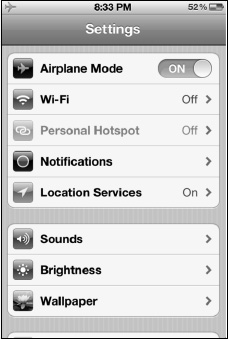
- Tap the Settings icon.
- Set the switch next to Airplane Mode in the top of the left column to ON.
- Notice that the Wi-Fi is automatically turned Off and that the Phone will not work.
TIP: Some airlines have in-flight Wi-Fi networks. On those flights, you may want to turn your Wi-Fi back On at the appropriate time.
You can turn your Wi-Fi connection Off or On by following these steps:
- Tap the Settings icon.
- Tap Wi-Fi near the top of the screen.
- To enable the Wi-Fi connections, set the switch next to Wi-Fi at the top of the page to ON.
- To disable the Wi-Fi, set the same switch to OFF.
- Select the Wi-Fi network and follow the steps the flight attendant provides to connect to in-flight Wi-Fi.
Touch Screen Basics
In this section, we will describe how to interact with the iPhone's touch screen.
Touch Screen Gestures
The iPhone has an amazingly sensitive and intuitive touch screen. Apple—renowned for making its iPad, iPod touch, and iPod devices easy-to-use—has come up with an excellent, even higher resolution, highly responsive touch screen.
If you are used to a physical keyboard and a trackball or trackpad, or even an iPod's intuitive scroll wheel, then this touch screen will take a little effort to master. With a little practice, though, you'll soon become comfortable interacting with your iPhone.
You can do almost anything on your iPhone by using a combination of the following:
- Touch screen “gestures”
- Touching icons or soft keys on the screen
- Clicking the Home button at the bottom
The following sections describe the various gestures you can use on your iPhone 4.
Tapping and Flicking
To start an app, confirm a selection, select a menu item, or select an answer, simply tap the screen. To move quickly through contacts, lists, and the music library in List mode, flick from side to side or up and down to scroll through items. Figure 6 shows both of these gestures.
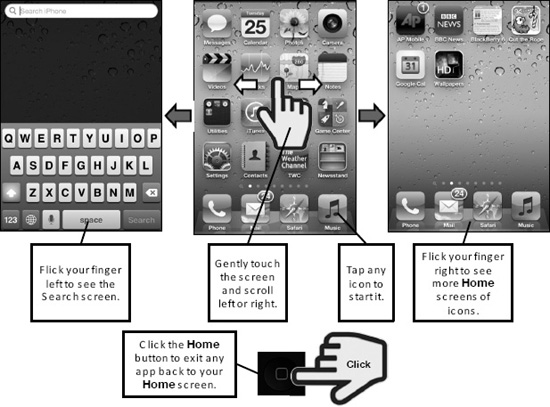
Figure 6. Basic touch-screen gestures
Swiping
To swipe, gently touch and move your finger as shown in Figure 7. You can also do this to move between open Safari web pages and pictures. Swiping also works in lists, such as the Contacts list.
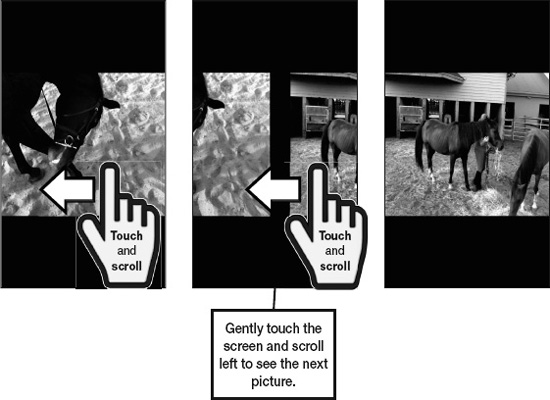
Figure 7. Touch and swipe to move between pictures and web pages.
Scrolling
Scrolling is as simple as touching the screen and sliding your finger in the direction you want to scroll (see Figure 8). You can use this technique in messages (email), newspaper and magazine apps, the Safari web browser, menus, and more.
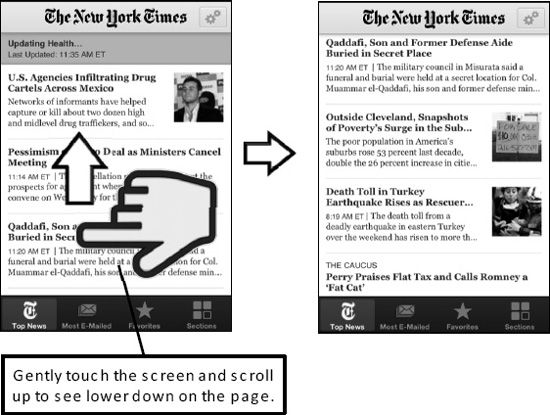
Figure 8. Touch and slide your finger to scroll around a web page, a zoomed picture, and more.
Double-Tapping
You can double-tap the screen to zoom in and then double-tap again to zoom back out. This works in many places, such as web pages, mail messages, and pictures (see Figure 9).
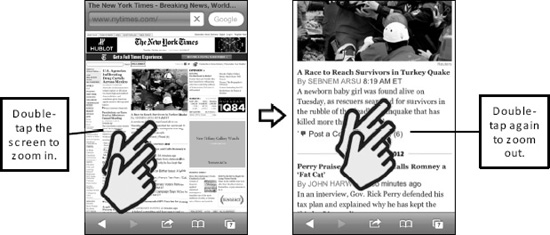
Figure 9. Double-tapping to zoom in or out
Pinching
You can also pinch open or closed to zoom in or out. This works in many places, including web pages, mail messages, and pictures (see Figure 10). Follow these steps to zoom in using the pinching feature:
- To zoom in, place two fingers that touch each other on the screen:
- Gradually slide your fingers open. The screen zooms in.
Follow these steps to zoom out using the pinching feature:
- To zoom out, place two fingers with space between them on the screen.
- Gradually slide your fingers closed, so they touch. The screen zooms out.

Figure 10. Pinch open to zoom in and pinch closed to zoom out.
App Reference Tables
This section gives you a number of handy reference tables that group the various apps that are pre-installed on your iPhone by their functionality. Also included in the tables are other useful apps you can download from the App Store. Each table gives you a brief description of the app and tells you where you can find more information about it in this book.
Getting Started
Table 2 provides some quick links to help you connect your iPhone to the Web (using Wi-Fior 3G); buy and enjoy songs or videos (using the iTunes, Music and Video apps); make your iPhone sleep or power off; unlock your iPhone; use the electronic Picture Frame; and more.
Stay Connected and Organized
Table 3 provides links for everything from organizing and finding your contacts to managing your calendar, working with email, sending messages, getting driving directions, calling people, and more.
Be Entertained
You can have lots of fun with your iPhone; Table 4 shows you how. For example, you can use your iPhone to buy or rent movies, check out free Internet radio with Pandora, or buy a book and enjoy it in a whole new way using iBooks. If you already use a Kindle, you can sync all your Kindle books to your iPhone and enjoy them right away. You can also choose from hundreds of thousands of apps from the App Store to make your iPhone even more amazing, fun, and useful. You can also rent a movie from Netflix or iTunes, downloading it immediately for later viewing (say on an airplane or train).
Stay Informed
You can also use your iPhone to read your favorite magazine or newspaper with up-to-the-minute vibrant pictures and videos (see Table 5). Or, you can use it to check out the latest weather reports.
Network Socially
You can also use your iPhone to connect and stay up-to-date with friends, colleagues, and professional networks using the social networking tools on your iPhone (see Table 6).
Be Productive
An iPhone can also help you be more productive. You can use it to access and read just about any PDF file or other document with the GoodReader app. You can take notes with the basic Notes app or step up to the advanced Evernote app, which has amazing capabilities for integrating audio, pictures, and text notes, and as well as syncing everything to a web site. You can also use your iPhone to set an alarm, calculate a tip, see what direction you are walking in, and record a voice memo (see Table 7).

